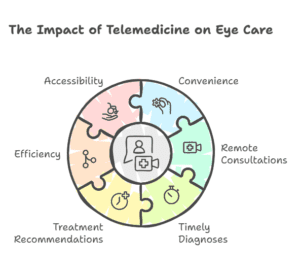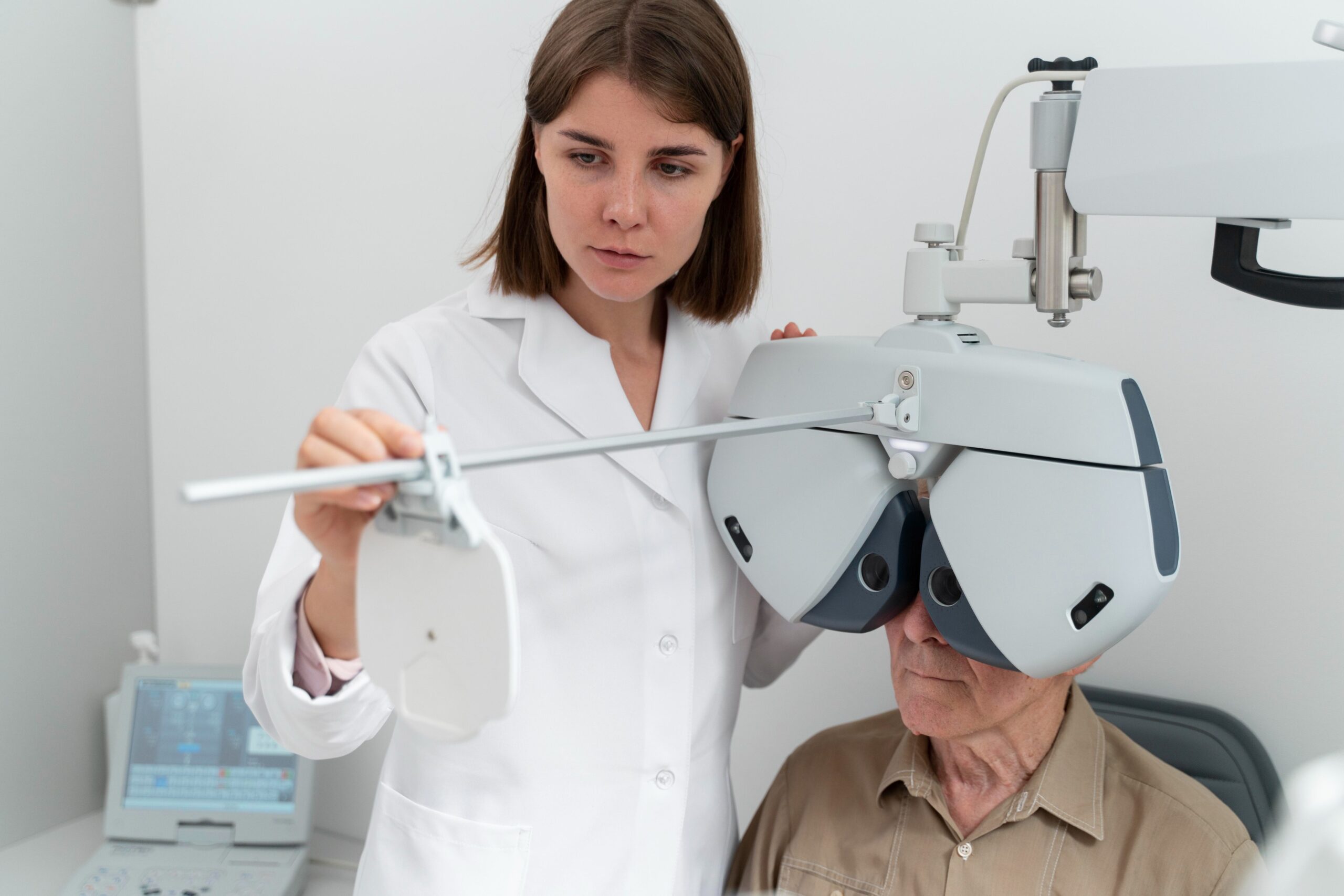Telemedicine is transforming various aspects of healthcare, and one area where its impact is especially profound is in eye health. Traditionally, vision care required in-person visits to an ophthalmologist or optometrist, but with the advancement of telemedicine, patients now have the option of receiving consultations, assessments, and follow-ups remotely. This shift is not only increasing accessibility for patients, but also improving efficiency, convenience, and outcomes in eye care.
In this article, we will explore how telemedicine is revolutionizing vision care by enhancing access, improving diagnostic capabilities, and enabling continuous monitoring of eye health.
Why Telemedicine is Changing Eye Care
Telemedicine has already been a game-changer in other specialties, and its role in eye care is proving to be just as transformative. Here’s why:
- Access to specialized care: Telemedicine allows patients in remote or underserved areas to consult with specialists without having to travel long distances.
- Convenience: Virtual consultations save time for both patients and providers, enabling quicker access to care.
- Early intervention: Telemedicine supports the early detection and management of eye diseases, reducing the risk of complications and vision loss.
- Continuous monitoring: Telemedicine facilitates ongoing monitoring of chronic eye conditions, ensuring that treatment plans remain effective and up to date.
With the ability to conduct comprehensive eye exams remotely, telemedicine is reshaping how patients interact with their vision care providers.

How Telemedicine Supports Eye Health
1. Remote Consultations for Eye Exams
Telemedicine enables patients to have consultations with eye care professionals remotely, making it more convenient to receive care without leaving home. Benefits include:
- Virtual eye exams: Through video calls and specialized diagnostic tools, ophthalmologists and optometrists can conduct preliminary eye exams, assess symptoms, and provide guidance.
- Improved access to specialists: Patients in rural areas or those with limited access to eye care providers can consult with specialists via telemedicine, eliminating the need for extensive travel.
- Timely care: Virtual consultations reduce wait times and allow for more rapid intervention, improving overall patient outcomes.
2. Telemedicine for Eye Disease Screening
Eye disease screening is crucial for detecting conditions like glaucoma, macular degeneration, diabetic retinopathy, and cataracts. Telemedicine supports these screenings by:
- Remote retinal imaging: Telemedicine allows patients to capture high-quality retinal images using specialized devices and send them to healthcare providers for evaluation, making it easier to detect early signs of eye diseases.
- Digital screening tools: Many telemedicine platforms offer digital tools for screening common eye conditions, such as tests for visual acuity, color vision, and eye pressure, which can be performed remotely.
- Monitoring at-risk populations: Patients with chronic conditions such as diabetes or high blood pressure can have their eyes monitored regularly through telemedicine, ensuring early detection of complications that could lead to vision loss.
3. Follow-up Care and Chronic Condition Management
Managing chronic eye conditions, such as glaucoma or macular degeneration, often requires regular check-ins and ongoing monitoring. Telemedicine enables healthcare providers to:
- Remote monitoring: Patients can send in data from home-based devices, such as intraocular pressure monitors, and receive feedback from their eye care providers without visiting the office.
- Patient education: Telemedicine platforms allow for interactive communication, enabling eye care providers to educate patients about their condition, treatment options, and lifestyle adjustments that can prevent further deterioration.
- Prescription management: Eye care providers can update prescriptions or recommend changes to treatment plans based on telemedicine consultations, reducing the need for frequent office visits.
4. Improving Access for High-Risk Populations
Certain populations, such as the elderly, those with disabilities, or people living in rural areas, face barriers in accessing traditional eye care services. Telemedicine helps address these barriers by:
- Improving mobility for the elderly: Older patients may have difficulty traveling to appointments, but with telemedicine, they can receive eye care consultations from the comfort of their homes.
- Reducing transportation challenges: Patients in rural areas or remote locations may not have easy access to transportation, but telemedicine provides a way for them to consult with specialists without the need to travel long distances.
- Serving underserved communities: Telemedicine makes it possible to bring eye care services to underserved communities, increasing access to timely and effective vision care.
5. Integration with Wearable Technology
Telemedicine in eye health is further enhanced by wearable technology that allows for continuous monitoring of eye health. Examples include:
- Smart glasses: Some wearable devices can track eye health by monitoring visual performance and sending data to healthcare providers for analysis.
- Continuous data collection: Wearables can collect data related to eye pressure, visual disturbances, or symptoms, allowing providers to monitor the patient’s condition in real-time and adjust treatment as needed.
- AI-driven diagnostics: Advanced AI algorithms integrated with wearable devices can analyze eye health data and detect potential issues, helping providers make informed decisions.
6. Enhancing Patient Education and Awareness
Telemedicine plays a vital role in educating patients about eye health, helping them understand their conditions and treatment options. How telemedicine helps:
- Virtual consultations for education: During virtual visits, providers can explain eye conditions in detail, answer patient questions, and provide guidance on preventing further damage.
- Interactive resources: Telemedicine platforms can offer educational materials, such as videos or interactive tools, to enhance patient understanding and adherence to treatment plans.
- Support for caregivers: Family members and caregivers of patients with vision impairments or chronic eye diseases can join virtual consultations to learn how to better support the patient’s eye health and overall well-being.
7. Emergency Eye Care
In emergency situations where patients experience sudden vision loss, eye injuries, or other urgent eye-related problems, telemedicine enables rapid access to care. Benefits include:
- Immediate consultation: Patients can quickly consult with an eye care provider for advice on how to manage the situation while seeking in-person care if necessary.
- Guidance for first-aid: For certain eye injuries, telemedicine providers can offer step-by-step instructions on how to care for the eye before arriving at an emergency facility.
- Reduced emergency room visits: By providing immediate access to eye care experts via telemedicine, patients can often avoid unnecessary trips to emergency rooms, reducing healthcare costs and improving care efficiency.
Conclusion
Telemedicine is revolutionizing eye health by providing increased access to care, improving diagnostic capabilities, and enabling better management of chronic conditions. It has expanded the reach of vision care, making it more accessible for patients in underserved areas, and enhancing the overall patient experience. As technology continues to evolve, telemedicine will only further transform how eye health is managed, improving patient outcomes and making vision care more efficient and convenient for all.
What People Are Asking
1. How does telemedicine help with eye health?
Telemedicine provides remote consultations, virtual screenings, and continuous monitoring for eye conditions, improving access to care and supporting better outcomes for patients.
2. Can telemedicine be used for eye disease screenings?
Yes, telemedicine allows for remote retinal imaging and other screenings for eye diseases, such as glaucoma, macular degeneration, and diabetic retinopathy.
3. How does telemedicine improve access to eye care?
Telemedicine improves access to eye care by allowing patients in remote or underserved areas to consult with eye care specialists remotely, eliminating the need for long-distance travel.
4. Can telemedicine manage chronic eye conditions?
Yes, telemedicine allows for continuous monitoring and follow-up care for chronic eye conditions like glaucoma, macular degeneration, and diabetic eye disease.
5. How does telemedicine benefit elderly patients with eye health issues?
Telemedicine makes it easier for elderly patients, who may have mobility challenges, to receive eye care consultations and ongoing treatment without needing to visit a healthcare facility.
Disclaimer
For informational purposes only; not applicable to specific situations.
For tailored support and professional services,
please contact Staffingly, Inc. at (800) 489-5877
Email: support@staffingly.com.
About This Blog: This Blog is brought to you by Staffingly, Inc., a trusted name in healthcare outsourcing. The team of skilled healthcare specialists and content creators is dedicated to improving the quality and efficiency of healthcare services. The team passionate about sharing knowledge through insightful articles, blogs, and other educational resources.
 Book a Demo to Build Your Team Today!
Book a Demo to Build Your Team Today!

 Read Case Studies
Read Case Studies 


 Virtual Medical Assistants
Virtual Medical Assistants



